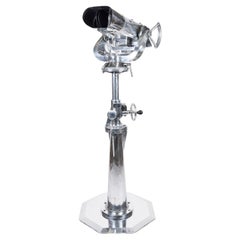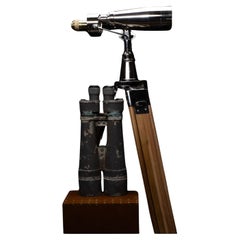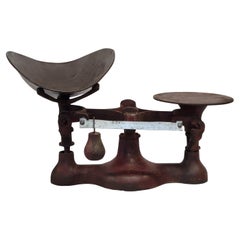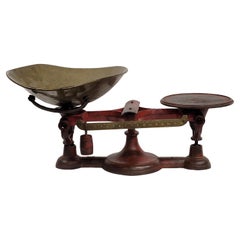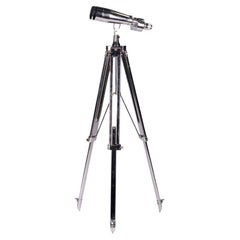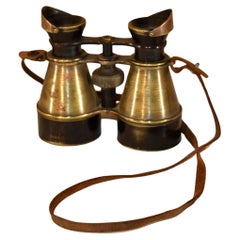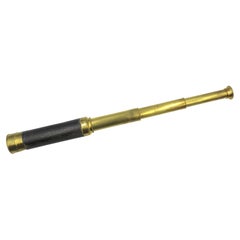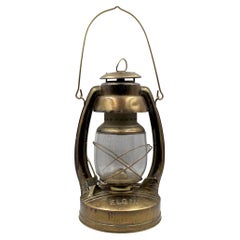Colorado Scientific Instruments
to
940
594
4
1
3
1
1
1
4
2
2
2
2
2
2
1
1
1
4
4
4
1
Item Ships From: Colorado
BMT 110 mm Binoculars
By Kazan
Located in Aspen, CO
BMT-110 Soviet Marine Binocular Telescope – 20x110mm Cold War Era Optics, Circa 1950s
Step into the history of Cold War surveillance and maritime observation with this rare Soviet B...
Category
20th Century European Colorado Scientific Instruments
Materials
Steel
$35,000
1940's WW2 Binoculars.
By Nikon
Located in Aspen, CO
Nikon marine binoculars mounted on a wooden period tripod, these exceptional binoculars display entirely Original optics in a distinctly Japanese straight-body instrument with 15mm x magnification with 80 mm objective naval lens that have been originally restored in a time-consuming process to reveal a crystal clear Image.A one of a kind pair of Nikon binoculars...
Category
1940s Japanese Vintage Colorado Scientific Instruments
Materials
Aluminum, Silver
$15,000
Antique Painted Red Cast Iron Scale
Located in Centennial, CO
A charming cast iron antique early 1900s scale with original red paint and a large brass tray. The weight is fixed, moving from side to side. The red paint...
Category
Early 20th Century American Rustic Colorado Scientific Instruments
Materials
Brass, Iron
Antique 19th century John Chatillon & Sons Painted Red Cast Iron and Brass Scale
Located in Centennial, CO
A charming cast iron John Chatillon & Sons scale with original red paint and a large brass tray. The weight is fixed, moving from side to side. J. Chatillon & Sons is stamped on the ...
Category
Late 19th Century American Rustic Antique Colorado Scientific Instruments
Materials
Brass, Iron
Related Items
Navy Binoculars
Located in Paris, FR
Binoculars Navy with polished steel adjustable tripod base.
With polished aluminium and steel binoculars with clear glass
lens, magnifying x8 times. Adjust...
Category
21st Century and Contemporary Indian Colorado Scientific Instruments
Materials
Aluminum, Steel
Pair of Brass Field Binoculars by W. Watson &. Sons of London
Located in High Point, NC
Pair of wonderfully aged brass field binoculars with moveable brass eye shields, which help to give clearer views without additional light coming through the sides. This pair of bin...
Category
1910s English Vintage Colorado Scientific Instruments
Materials
Brass
20th Century Japanese Pair Of Naval Bridge "Big Eye" Binoculars By Nikon c.1940
By Nikon
Located in Royal Tunbridge Wells, Kent
A rare 20th Century set of Japanese naval bridge “big eye“ binoculars by Nikon manufactured during WWII by Tokyo Kogaku Kikai (Tokyo Optical Company). They have been expertly cleaned...
Category
20th Century Japanese Other Colorado Scientific Instruments
Materials
Metal
$10,213 / set
H 42.13 in W 8.27 in D 19.3 in
Vintage WW2 Era Genco "Four Aces" Military Pilot Pinball Machine Back Glass
Located in Hamilton, Ontario
This vintage back glass was made by Genco of the United States for their 'Four Aces" military inspired pinball arcade game. The back glass is presumably silk screened in multiple col...
Category
Mid-20th Century American Mid-Century Modern Colorado Scientific Instruments
Materials
Glass
$899
H 21 in W 21 in D 0.13 in
Antique "Le Jockey Club" 1930's Horse Racing Binoculars with Compass
Located in Vancouver, British Columbia
A French silvered brass and brown leather Horse Racing binoculars stamped "Le Jockey Club Paris" presented in their original brown leather case. ...
Category
Early 20th Century French Mid-Century Modern Colorado Scientific Instruments
Materials
Brass
$440 Sale Price
20% Off
H 3 in W 4.5 in D 2 in
20th Century Japanese Naval Bridge "Big Eye" 15X80 Binoculars By Nikon c.1940
By Nikon
Located in Royal Tunbridge Wells, Kent
A rare mid 20th Century set of Japanese naval bridge “big eye“ binoculars by Nikon manufactured during WWII by Tokyo Kogaku Kikai (Tokyo Optical Company). They have been expertly cle...
Category
20th Century Japanese Other Colorado Scientific Instruments
Materials
Metal
$14,983
H 74.81 in W 44.89 in D 44.89 in
Quirky Stick Stand, made with a WW1 Propellor
Located in Godshill, Isle of Wight
Quirky Stick Stand, made with a WW1 Propellor
This an attractive piece of early nostalgic memorabilia, the propeller is made in wood and originates from an early aeroplane, it is silver at the tip, it stands on a teak plinth...
Category
Early 20th Century Folk Art Colorado Scientific Instruments
Materials
Bentwood
Pair Of WWII Carl Zeiss Binoculars, 12 x 60
By Carl Zeiss
Located in Oxfordshire, GB
Carl Zeiss 12 x 60 Binoculars.
A pair of rare Second World War Carl Zeiss 12 x 60 German ex military binocular director telescope for a 4 m rangefinder. These observation binoculars ...
Category
20th Century German Colorado Scientific Instruments
Materials
Metal
WW2 Sterling Silver Vintage Dunhill Military Trench Service Lighter
By Dunhill
Located in Van Nuys, CA
This sterling vintage Dunhill Service Lighter, crafted from 925 sterling silver, dates back to the World War II era and was made in the USA. Known as a trench or military lighter, it...
Category
1940s American Vintage Colorado Scientific Instruments
Materials
Silver
Vintage Observation Binoculars by Toko, Japan, 20 X 120
Located in Oxfordshire, GB
Japanese Ex-navy 20 x 120 binoculars.
A large pair of Japanese ex-navy observation binoculars mounted on a vintage adjustable wooden tripod. The WWI...
Category
1940s Japanese Industrial Vintage Colorado Scientific Instruments
Materials
Aluminum
$23,438 Sale Price
20% Off
H 9.45 in W 12.01 in D 29.93 in
1940's WW2 Carl Zeiss BLC Flak 12x60 Anti Aircraft Binoculars
By Carl Zeiss
Located in Leicester, Leicestershire
Carl Zeiss blc Flak 12 x 60 binoculars.
A beautiful set of WW2 binoculars in excellent condition made in Germany during World War 2. These were designed to be used in conjunction wi...
Category
1940s German Industrial Vintage Colorado Scientific Instruments
Materials
Aluminum
$10,561
H 59.06 in W 27.56 in D 27.56 in
Vintage Military Campaign Used Ammunition Box from Ww2 Stunning Period Patina
Located in West Sussex, Pulborough
We are delighted to offer for sale this period Military Campaign used, WW2 Ammo box with all the original patina
I have two of these for sale, the second piece is listed under my ...
Category
20th Century European Campaign Colorado Scientific Instruments
Materials
Metal
$511
H 11.62 in W 17.52 in D 14.57 in
Previously Available Items
Antique Brass Three-Draw Telescope, 19th Century
Located in Colorado Springs, CO
This antique three-draw telescope dates to the 19th century. Solidly crafted with brass draws and a brass barrel wrapped in leather, this antique telescope is a beautiful example of ...
Category
19th Century French Antique Colorado Scientific Instruments
Materials
Brass
Vintage Elgin Kerosene Lantern, Early 20th Century
By Elgin American Mfg Co.
Located in Colorado Springs, CO
Presented is a vintage Elgin railroad kerosene lantern, with a clear glass globe and wire caging. The lantern was originally used on the Chicago Auro...
Category
Early 20th Century American Colorado Scientific Instruments
Materials
Metal
Vintage Underwood Standard Typewriter No. 5, 1924
By Franz Wagner
Located in Colorado Springs, CO
Presented is a vintage Underwood Standard Typewriter No. 5 model. Made in the United States in 1924, this glorious black and gold typewriter is the most successful of the early Underwood typewriter models. The No. 5 would look fantastic in a study, on a bookshelf, or in an office.
The Underwood typewriter is the creation of German-American inventor Franz X. Wagner. In the early 1890s, Wagner, who had already designed earlier typing machines...
Category
1920s American Vintage Colorado Scientific Instruments
Materials
Metal
Vintage Gimbal-Mounted Compass by Wilcox, Crittenden & Co.
Located in Colorado Springs, CO
Presented is a Victorian-era gimballed compass by Wilcox, Crittenden & Co. of Middletown, Connecticut. The brass compass is beautifully constructed and fitted in its original wooden lidded box. The compass is mounted on a 360-degree brass gimbal ring system. The gimbal ring design allows the compass to remain level regardless of the angle of the base or how much the ship may have pitched or rolled on the open waters. The compass card is black and white and is marked with the Wilcox, Crittenden & Co. monogram at true north.
The company that would eventually become Wilcox, Crittenden & Co. was first established by Eldridge H. Penfield and his uncle Ira Penfiels in 1847 in Middletown, Connecticut. Middletown was New England;s largest inland port. Eldridge Penfield is famous for first conceiving of a metal grommet to replace rope grommets used by sailors. The Penfields hired Walter Wilcox, cousin to Eldridge Penfield, to operate the hand stamping tool that fabricated the metal grommets.
As steamships gradually replaced sailing, the company’s expanded their line to make and sell all sorts of nautical hardware and instruments. Their 1870 catalog offered such varying products as shackles, thimbles, ring bolts, “Ereful whistles,” engine-room signals, boat nails...
Category
1880s American Late Victorian Antique Colorado Scientific Instruments
Materials
Brass
Carl Zeiss 12 x 60 German Observation Binoculars, Second World War
Located in Colorado Springs, CO
This is an exceptional 20th century WWII German 12x60 observation binocular, presented on an adjustable wooden tripod. The binoculars were manufactured by the company Carl Zeiss. Carl Zeiss is a German manufacturer of optical systems, founded in Jena, Germany in 1846 by optician Carl Zeiss. These binoculars were used for long-watch land and sky observation by German forces between 1939 and 1945.
The binoculars were ruggedly constructed to withstand the rigors of field service. They were used for various tasks, including daylight observation of enemy troop movements, directing fire from artillery toward advancing enemy troops and armor, directing fire at enemy aircraft, and night observation. The angle of the binoculars allowed the observer to sustain watch for long periods of time. The angle also permitted a necessary versatility, as the watchman was able to perform both higher aerial observation and observation of enemy troops on the same visual plane as the watchman.
The wartime code for this binocular, “blc”, is engraved on the side of the binocular. “blc” is the secret manufacturing code assigned to Zeiss by the German Army Ordnance Department. The use of the “blc” code instead of the company’s normal logo on the side was a precautionary one, to ensure the secrecy of factory production should the binocular fall into enemy hands.
World War II binoculars are true military weapons, designed for defense and reconnaissance. They were never designed for civilian use, and were constructed without cost in mind, as the reliability of the optics far outweighed the monetary cost. The eyepieces can be adjusted for focus and the distance between your eyes with a turn of a knob, as can the shade settings for the lenses. This particular binocular also possesses sun filters. It was a known military tactic to fly in line with the sunlight and filters helped to cut the glare of the sun to increase plane and bomber tracking.
This stunning antique...
Category
1940s Vintage Colorado Scientific Instruments
Materials
Metal
Oak Balance Scale with Marble Top, circa 1850
By Henry Troemner
Located in Evergreen, CO
Well known balance maker, Henry Troemner, from Philadelphia crafted this marble top scale. It was made prior to his death, likely between 1844 and 1852. It has the original two brass...
Category
Mid-19th Century American Antique Colorado Scientific Instruments
Materials
Marble, Brass, Iron
Recently Viewed
View AllMore Ways To Browse
Antique Laboratory Scales
Antique Pharmacy Scales
Antique Weather Forecast
Medical Skull
Retro Weather Thermometer
Vintage Brass Telescope
Vintage Fire Department Collectibles
Vintage Military Tripod
Antique Brass Sundials
Antique Dental Instrument
Edwardian Barometers
Large Abacus
Movie Projector
Smoke Mask
Vintage Camera With Leather Case
18th Century Telescope
Antique Avery Scales
Antique Brass Surveying Instruments
